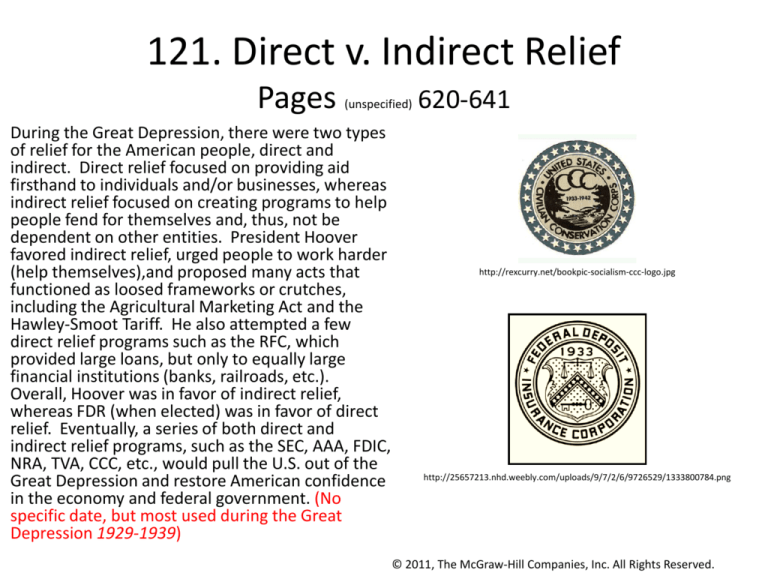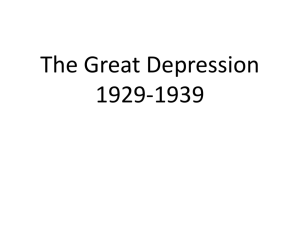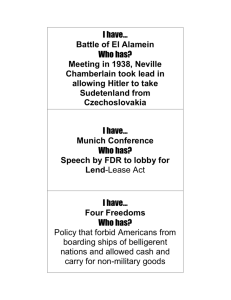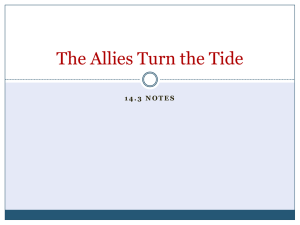
121. Direct v. Indirect Relief
Pages
(unspecified)
During the Great Depression, there were two types
of relief for the American people, direct and
indirect. Direct relief focused on providing aid
firsthand to individuals and/or businesses, whereas
indirect relief focused on creating programs to help
people fend for themselves and, thus, not be
dependent on other entities. President Hoover
favored indirect relief, urged people to work harder
(help themselves),and proposed many acts that
functioned as loosed frameworks or crutches,
including the Agricultural Marketing Act and the
Hawley-Smoot Tariff. He also attempted a few
direct relief programs such as the RFC, which
provided large loans, but only to equally large
financial institutions (banks, railroads, etc.).
Overall, Hoover was in favor of indirect relief,
whereas FDR (when elected) was in favor of direct
relief. Eventually, a series of both direct and
indirect relief programs, such as the SEC, AAA, FDIC,
NRA, TVA, CCC, etc., would pull the U.S. out of the
Great Depression and restore American confidence
in the economy and federal government. (No
specific date, but most used during the Great
Depression 1929-1939)
620-641
http://rexcurry.net/bookpic-socialism-ccc-logo.jpg
http://25657213.nhd.weebly.com/uploads/9/7/2/6/9726529/1333800784.png
© 2011, The McGraw-Hill Companies, Inc. All Rights Reserved.
122. Election of 1932
Pages 623-625
This election was primarily between Herbert
Hoover (Republican) and Franklin Delano
Roosevelt (Democrat). FDR ran on the
platform that he would offer more energetic
efforts to help end the Great Depression
than Hoover had done. Nobody doubted
that FDR would win the election and, in
1932, FDR won by a landslide. He received
57.4% of the popular vote to Hoover’s 39.7%
and won every state except Delaware,
Pennsylvania, Connecticut, Vermont, New
Hampshire, and Maine. The election of
1932 saw the American people mandate
change and they would soon find it in the
New Deal.
http://voteview.com/images/Election_of_1932.jpg
© 2011, The McGraw-Hill Companies, Inc. All Rights Reserved.
123. Fireside Chats
Page 628
During FDR’s Presidency, he introduced the
concept of holding fireside chats. These
were radio broadcasted speeches that
Roosevelt gave while sitting fireside in the
Whitehouse. He used these chats to explain
his programs and plans to the people in
simple terms. The fireside chats helped
restore people’s confidence in the
government, as they could now hear the
president speak to them personally in their
own homes, and produced a good image for
the Roosevelt Administration. These chats
occurred throughout FDR’s presidency.
http://4.bp.blogspot.com/_XdUZ_8oMAT4/TVK4QpLZ6SI/AAAAAAAAD6w/RIzIi30uiLc/s1600/roosevelt+fireside.jpg
© 2011, The McGraw-Hill Companies, Inc. All Rights Reserved.
124. New Deal Legislation
Pages 628-634
Legislation passed by the New Deal had one
primary goal, helping to pull America out of
the Great Depression and rebuild it.
•
Emergency Banking Act (1932)
–
•
Glass-Steagall Act (1933)
–
•
Revitalized the Tennessee Valley, improved water transportation, eliminated
flooding in the area, and provided electricity to thousands who did not have
it
Federal Emergency Relief Administration (1933)
–
•
Helped promote socioeconomic growth and created the NRA
Tennessee Valley Authority (1933)
–
•
Promoted agriculture and helped revive the industry and created the AAA
National Industrial Recovery Act (1933)
–
•
http://1.bp.blogspot.com/-fGJrw4GuC64/T1n1kw9xIgI/AAAAAAAAAYY/744XAvT7WEA/s1600/78319-004-545F8CDD.jpg
Restored faith in the stock market
Agricultural Adjustment Act (1933)
–
•
Created the FDIC and helped restore faith in the banks
Securities & Exchange Commission (1933)
–
•
Helped restore faith in the banks
Provided cash grants to prop up bankrupt relief agencies
Civilian Conservation Corps (1933)
–
Provided temporary jobs and thus aided in increasing economic flow
http://upload.wikimedia.org/wikipedia/commons/3/3b/NewDealNRA.jpg
© 2011, The McGraw-Hill Companies, Inc. All Rights Reserved.
125. “100 Days”
Pages 628-631
“100 Days” refers to FDR’s first one hundred days in office.
During Franklin Roosevelt’s first “100 days,” he saw to the
passage of many acts and the creation of many governmentfunded programs. He passed many acts in his attempts to
relieve America from the Great Depression, including the
Emergency Banking Act, the Glass-Steagall Act, and the
National Industrial Recovery Act. The Emergency Banking Act
helped to reform America’s banking system, by requiring
federal inspection of banks and providing federal support to
failing banks. The Glass-Steagall Act also helped to reform the
banking system, by curbing irresponsible speculation by banks
and creating the FDIC, which insured all bank accounts for up
to $2,500. The National Industrial Recovery Act reformed the
American working condition, by setting a minimum wage,
setting a maximum work week, and banning child labor.
Programs such as the SEC, AAA, and CCC helped society and
the economy as well; the SEC provided stock market reform,
the AAA provided helped to promote agriculture, and the CCC
helped provide temporary jobs to the unemployed and raised
environmental awareness. In short, FDR’s first “one hundred
days” were extremely productive and showed the American
public that he truly planned to help with the Great Depression,
thus raising their confidence in both the government and in the
economy.
http://www.earlyword.com/wp-content/uploads/2008/11/fdr.jpg
Date: The 100 Days after FDR’s Inauguration
© 2011, The McGraw-Hill Companies, Inc. All Rights Reserved.
126. Social Security
Pages 639-640
In 1935, FDR aided in the passage of the
Social Security Act. It created several
programs focused on need-based assistance.
Helped increase the economic flow and
restore confidence in the American
government.
• Elderly
–
Could receive up to $15/month
• Pension System
–
Employers and employees contribute to a trust that
provides them with monthly checks upon retirement.
• Unemployment Insurance
–
Worked basically the same way as welfare
• People With Disabilities
–
•
Received monthly aid due to their inability to perform
well in workplaces
Mothers
–
Received monthly aid to help raise their children
http://socialsecurity.procon.org/files/1-social-security-images/social-security-poster-circa-1935-picture.jpg
© 2011, The McGraw-Hill Companies, Inc. All Rights Reserved.
127. Court-Packing Plan
Pages 642-643
In February 1937, FDR proposed an overhaul
of the federal courts, wishing to add six new
judges to the supreme court. He wanted to
do this in order to give control of the Judicial
Branch to the Democrats, as he had the
power to choose the new judges. This
created a large amount of dissent in the
federal government and hurt FDR’s public
image because people began to see him as
power-hungry. Eventually, the issue was
quelled by the Supreme Court, who voted on
the topic and terminated it.
http://images.fineartamerica.com/images-medium-large/1-new-deal-supreme-court-granger.jpg
© 2011, The McGraw-Hill Companies, Inc. All Rights Reserved.
Cash-and-Carry/Lend-Lease p.661,663
• The Cash-and-carry said that in order for countries to trade
with the United States, they would have to go to the United
States, pay in cash, and ship and handle it themselves. This
was enacted by 1939. The Lend-Lease allowed the United
States government to lend or lease armaments to any nation
deemed “pivotal to the defense of the United States. Congress
enacted the bill in March 1941.
• Significance: These laws provided the Allies with needed
supplies, and looked to help Great Britain and the Allies
World War II. This kept Great Britain out of bankruptcy and in
the war.
Attack on Pearl Harbor p.666-667
• This was a Japanese bomb raid on Pearl
Harbor on December 7, 1941. In this surprise
attack on the United States, America lost
major amounts of ships and aircraft, while
Japan lost a very few number of airplanes.
• Significance: Even though this attack was a
total blow out on the Americans, it actually
had a positive affect on America and the
Allies. Americans were now inspired to join
the war effort in Europe, and they did after
this attack. The Japanese also failed to take
out any aircraft carriers, and they also did not
take out other key aspects to America’s war
effort. This attack led to the United States to
join World War II, which would ultimately
lead to the Allies’ victory.
Holocaust p.674-675
• This was the name given to the Nazi campaign to exterminate
the Jews of Europe. The Nazis blamed the Jews for losing
World War I, and therefore looked to purify Europe of all Jews
by starting World War II. This lasted from 1939-1945.
• Significance: This was extremely immoral and cruel. The Jews
were put in concentration camps which meant emanate
death. America did not know how bad this prosecution was,
and therefore they did not intervene into the Holocaust. They
were criticized for being immoral and not caring about the
Jews.
Battle of Midway p.671
• This was a battle on Midway Island which was not far from
Hawaii. This was Japan’s last offensive against the United
States in the Pacific Ocean in World War II. This victory for the
United States was from June 3-6, 1942.
• Significance: Despite terrible losses, the United States held
defeated the Japanese, and they totally decimate the
Japanese navy. This gave the United States control of the
Central Pacific. This was a major turning point in the battle in
the Pacific.
D-Day Invasion p.689
• This is Allied forces (mainly Great Britain, Canada, and the
United States) land on the French beaches of Normandy on
June 6, 1944. They attacked with three million troops and
perhaps the greatest array of naval armaments ever
assembled.
• Significance: The Allies’ defeat and break throughout the
German lines who had been ready for the attack. This started
the Allies’ last offensive on the Eastern front which would
eventually lead to the invasion of Germany and the end of the
war.
Battle of the Bulge p.689
• This was Germany’s last offensive push
against the Allies. In this battle (named
for a large bulge that appeared in the
American lines as the Germans passed
forward), they drove 55 miles toward
Antwerp before they were finally
stopped at Bastogne. This battle
happened from 16 December 1944 to
25 January 1945.
• Significance: This was the German’s last
offensive push and their last hope to
win the war. The Allies soundly defeat
them and push them back into
Germany. This battle was the last major
battle on the Western front.
Battle of Leyte Gulf PG. 691
Date: 23–26 October 1944
SIG: The largest naval battle of
World War II (4 Japanese aircraft
carriers sunk), and by some
considered the largest naval battle
in history. This battle prevented
Japan’s expansion into the South.
The US successfully won this
battle.
http://www.militaryhistoryonline.com/wwii/articles/images/leyte.jpg
http://www.ouroldnavy.com/images/gb_at_samar.jpg
Battle of Okinawa PG. 691
Date: 1 April – 22 June 1945
SIG: Largest amphibious assault
in the Pacific War of World War
II. The battle was also Japan’s last
offensive effort against the US.
Kamikaze attacks were popular in
this battle and lead to many
casualties on both sides. The
bombings on Hiroshima and
Nagasaki caused Japan to
surrender just weeks after the end
of the fighting at Okinawa. The
US won this battle.
http://www.japanfocus.org/data/2.okbattle.map.jpg
Axis/Allies PG. 670-696
Date: 1939 – 1945
SIG: These were the two
powers that fought against
each other in World War II.
The Axis powers consisted of
Germany (Hitler), Italy
(Mussolini) and Japan. The
Allied powers consisted of the
US (Roosevelt), Britain
(Churchill) and the Soviet
Union (Stalin).
http://upload.wikimedia.org/wikipedia/commons/thumb/7/73/1938_Naka_yoshi_sangoku.jpg/170px-1938_Naka_yoshi_sangoku.jpg
Manhattan Project PG. 692-5
Date: 1942 – 1946
SIG: The best kept secret of
WWII. This project was credited
with the creation of the atomic
bomb used at Hiroshima and
Nagasaki. Led by Robert
Oppenheimer, with the project’s
success of the creation of the
atomic bomb, the US could finally
and easily end the war against
Japan by threatening them with
the new weapon.
http://www.atomicarchive.com/History/mp/Images/H10.jpg
Containment Doctrine PG. 702-3, 708
Date: 1944 - 1953
SIG: The policy created by the
United States to prevent the
spread of Communist subversion
(attack from within) in the federal
government. A component of the
Cold War, this policy was
launched in response to a series of
moves by the Soviet Union to
enlarge communist influence
across the world. The doctrine
also prevented Communism from
increasing while instituting the
basis of American foreign policy.
http://www.sjsapush.com/resources/image002.jpg
Alger Hiss/Rosenberg Case PG. 719
Date: 1948 - 1951
SIG: Alger Hiss was involved in the
establishment of the United Nations.
He was later accused of being a Soviet
spy in 1948 and convicted of perjury
with this charge. Ethel and Julius
Rosenberg were US citizens convicted
of conspiracy to commit espionage
during a time of war, and executed.
Their charges were made on the
account of passing info about the
atomic bomb to the Soviet Union. Both
Hiss and the Rosenberg’s lead to the
growing fear of Communist subversion.
http://revision4gcses.files.wordpress.com/2011/03/alger-hiss1.jpg
McCarthyism PG. 717-721, 750-1
Date: 1950 - 1956
SIG: Joseph McCarthy’s practice of accusing
people of being Communist, disloyal, or
treasonous without actual evidence. The
Wisconsin-based Republican fought against
Communist subversion in the US
government. McCarthy’s accusatory
speeches led to the growing fear of
subversive Communism in the American
government. Although there was no proof to
back up his accusatory claims, he became
very popular among the American people.
http://upload.wikimedia.org/wikipedia/commons/thumb/f/fa/Joseph_McCarthy.jpg/220px-Joseph_McCarthy.jpg






